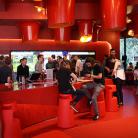
Connecting coursework with industry Faculty Spark - View, reflect and apply
Last updated on 20/11/2020
-
You must be signed in to access this function
4
Description
Dr Leigh Ellen Potter shares her experience connecting coursework with a strong industry focus to improve her Information Technology students’ application of theory and employability skills.
Challenge
In an effort to improve student application of theory throughout the course, Dr Leigh Ellen Potter identified issues that students needed to be aware of:
- the connection between theory and application and what that means to them as potential information technology professionals
- why industry context is beneficial.
There are major benefits to industry derived assessment in Information Technology, it's what helps prepare students for employability. Students don't always have the background experience and world knowledge to understand why they should study Human Computer Interaction, so by giving things a more industry focus, they could see how those changes could relate to their employment later. Moving students from extrinsic motivation to intrinsic motivation has many benefits also in how they approach their studies.
Approach
Some of the approaches were:
- Scaffolding the content so that students get the theory in online modules and then do an interactive lecture where we go through the theory again.
- Students were given questions to answer during the lecture.
- During the workshops students were given actual tangible industry activities where they can apply this theory as well.
We do actual usability evaluations based on a current industry client providing benefit to both the client and students. Students are challenged with then taking that away and applying both the theory learnt in lectures and workshops and applying this to current assessment tasks.
Through these approaches, students then start to make that connection between theory and what it means in practice.
Outcomes
Some of the outcomes for the students were:
- designing a real product for a real client
- the chance to have their design brief given to the client at the end of the course
- students have a tangible piece of work to use as a portfolio piece
- strong tie-ins with the employability framework - not just from engagement with an industry client but also with the development of core design skills.
These all raised the employability aspects for the students and were completely achievable.
Enabling Technology
To make all this happen, the entire course site is presented as modules using Learning@Griffith (Blackboard) Learning Module structures. Students get a module book (lecture slides, workshop exercises) and a series of electronic support resources. Further support materials are also provided as general help guides with "Want to go deeper" resources provided for the advance students wanting to know more.
Implement
If you're considering using this approach for your teaching, Leigh Ellen's advice for others is that each lecture has a simple activity asking "What's working", "What isn't", "What can I fix for you?" In the following week show results and show how any issues have been addressed, Leigh Ellen found that this provides greater student buy-in. Also, whenever trialing any new technique, make sure you ask for student feedback, respond to that feedback and make sure you tell students about these updates etc.
Don't make assumptions about what students do and don't know...
Next Steps
Leigh Ellen and her teaching team are reviewing and revising their strategies for the upcoming courses offered, taking into account the different year levels of the students in the program:
Things we found in review were what works for 2nd years didn't work the same or as well for 1st years, so we'll need to reassess. The process we are taking is currently in implementation and will be reviewed at the end of year/course. This will allow us to regroup, reassess and also follow feedback from the students as to how we go forward.
Support Resources
Contributed by
-
Griffith Sciences
School of Information and Communication Technology
Leigh Ellen Potter
373 55191
l.potter@griffith.edu.au
http://orcid.org/0000-0003-3747-1335
Griffith Experts profile -
Learning Futures
Licence
© 2024 Griffith University.
The Griffith material on this web page is licensed under a Creative Commons Attribution NonCommercial International License (CC BY-NC 4.0). This licence does not extend to any underlying software, nor any non-Griffith images used under permission or commercial licence (as indicated). Materials linked to from this web page are subject to separate copyright conditions.
Preferred Citation
(2020). Connecting coursework with industry. Retrieved from https://app.secure.griffith.edu.au/exlnt/entry/3588/view


